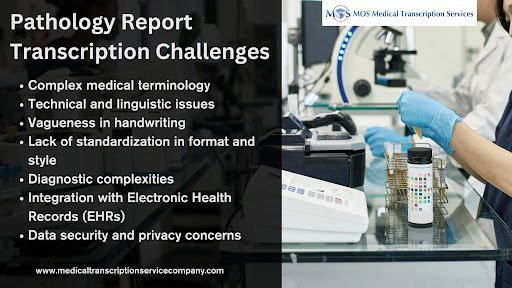
Pathology reports serve as the cornerstone of communication between pathologists, clinicians, and other healthcare professionals. These reports include diverse data, including lab results, patient records, diagnostic reports, and autopsy reports. Pathologists meticulously analyze these records to ensure proper diagnoses. Medical transcription outsourcing helps pathologists maintain accurate and timely records. The process of transcribing pathology reports presents a unique set of challenges that demand attention and precision.

Challenges Faced in Transcribing Pathology Reports
- Complex medical terminology: Pathology reports are often filled with medical terminology, including complex anatomical descriptions, diagnostic terms, and scientific jargon. A robust understanding of these terms is necessary to ensure accurate and contextually appropriate transcription. Misinterpretation of medical terminology can lead to serious consequences, affecting patient care and treatment plans.
- Vagueness in handwriting: The reports pathologists generate might be hastily written or contain illegible handwriting. It can be challenging to decipher these handwritten notes accurately. Ambiguities in handwriting can lead to errors in transcribing critical information, potentially impacting patient care and diagnosis.
- Varied formats and styles: Pathology reports come in various formats and styles, depending on the institution, laboratory, or even the individual pathologist. They often lack standardization, making it challenging for transcriptionists to adapt to different styles efficiently. Consistency in transcription is crucial to maintain the integrity of the information across various reports.
- Diagnostic complexity: Pathology reports deal with a wide range of medical conditions, and the complexity of diagnoses can vary significantly. Some reports may involve straightforward diagnoses, while others might require in-depth knowledge and expertise. Transcriptionists need to be well-versed in the nuances of different medical conditions to accurately transcribe and convey the diagnostic information.
- Integration with Electronic Health Records (EHRs): With the increasing adoption of electronic health records (EHRs), there is a growing need for seamless integration between transcribed pathology reports and digital health systems. Ensuring accurate and timely entry of pathology data into EHRs is crucial for maintaining the continuum of patient care. Transcriptionists must navigate the intricacies of different EHR systems and understand the specific requirements for data entry.
- Data security and privacy concerns: Such records contain sensitive patient information, making data security and privacy paramount. Transcriptionists must adhere to strict confidentiality protocols and ensure that the transcription process complies with healthcare privacy regulations such as HIPAA. Any lapses in security can lead to breaches and compromise patient privacy.
Continuous education and training, combination of domain knowledge, and attention to detail are essential for transcriptionists to overcome these challenges and ensure accurate pathology transcription for precise diagnosis, effective patient care, and seamless communication among healthcare professionals.

